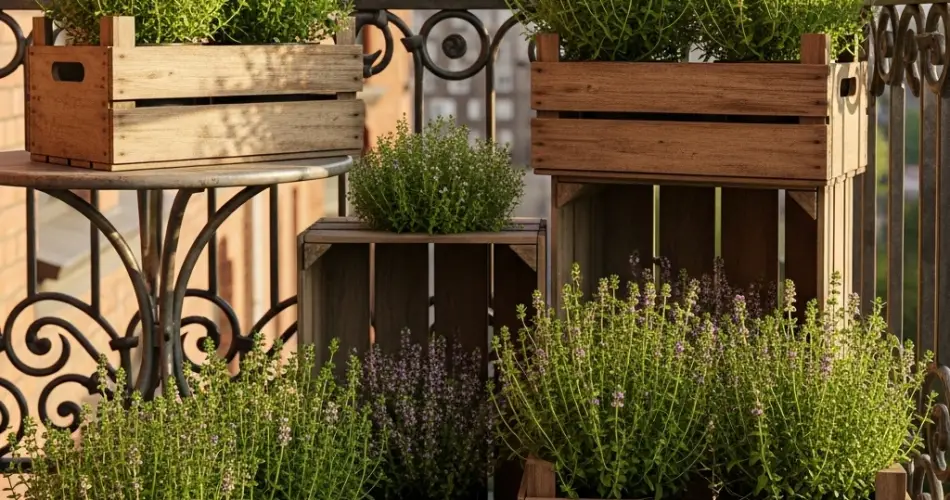Balcony gardens are a wonderful way to add greenery, fragrance, and fresh ingredients to your home—even when outdoor space is limited. Among the many herbs that thrive in compact setups, thyme stands out for its rich aroma, culinary versatility, and easy-care nature. Growing thyme in wooden crates not only makes the most of your balcony space but also adds a rustic, decorative touch to your urban garden.
With the right setup and a few simple care tips, thyme grown in crate planters can flourish, providing you with an endless supply of flavorful leaves for cooking all year round.
Why Thyme Thrives in Crates
Thyme is a hardy Mediterranean herb that naturally grows in rocky, well-drained soil under plenty of sunlight. Crate planters mimic these conditions perfectly, allowing water to drain easily while giving the roots room to breathe.
Benefits of crate planting thyme:
-
Excellent drainage: Prevents root rot and fungal issues.
-
Space efficiency: Great for small balconies or patios.
-
Portability: Easily moved to follow the sun or protect from harsh weather.
-
Decorative charm: Adds rustic style to your balcony décor.
Choosing and Preparing Your Crate
1. Select the Right Crate
Choose a sturdy wooden crate, ideally repurposed from fruit or wine storage. Make sure it’s untreated wood, as chemicals from treated timber can leach into the soil and harm edible plants.
2. Add a Liner
Line the inside with landscape fabric, burlap, or breathable plastic sheeting with drainage holes. This prevents soil from spilling out and prolongs the life of the wood.
3. Ensure Drainage
If the crate doesn’t already have drainage holes, drill several in the bottom. Good drainage is essential for thyme’s health.
4. Position for Sunlight
Thyme loves full sun, so place your crate where it will receive at least 6–8 hours of direct light each day. A south-facing balcony is ideal.
Planting Thyme in Crates
1. Select Your Thyme Variety
Different types of thyme offer unique flavors:
-
Common Thyme: Classic flavor for everyday cooking.
-
Lemon Thyme: Bright, citrusy aroma.
-
Creeping Thyme: Decorative and fragrant ground cover.
2. Use the Right Soil
Fill your crate with a light, well-draining potting mix. You can blend in coarse sand or perlite to further improve drainage. Thyme prefers a slightly alkaline to neutral pH (6.0–8.0).
3. Spacing
Plant thyme seedlings or cuttings about 8–10 inches apart to allow airflow and prevent overcrowding.
Watering and Feeding
Thyme thrives on minimal watering. Let the top inch of soil dry before watering again. Overwatering can cause root rot, so it’s better to keep the soil slightly dry than consistently moist.
As for feeding, thyme isn’t a heavy feeder. Apply a diluted, balanced liquid fertilizer every 6–8 weeks during the growing season. Over-fertilizing can lead to excessive leaf growth with less flavor.
Pruning and Harvesting
Regular pruning keeps your thyme plant healthy, bushy, and productive. To harvest:
-
Use clean scissors or pruning shears to cut stems just above a set of leaves.
-
Avoid removing more than one-third of the plant at once.
-
Frequent harvesting encourages new growth and prevents the plant from becoming woody.
For long-term storage, dry your thyme by hanging small bundles in a well-ventilated area out of direct sunlight. Once dried, strip the leaves from the stems and store them in an airtight jar.
Managing Pests and Diseases
Thyme is naturally pest-resistant, but you may occasionally see aphids, spider mites, or whiteflies. Remove them by:
-
Spraying with a gentle stream of water.
-
Applying organic insecticidal soap if needed.
To prevent fungal diseases, ensure proper air circulation and avoid overwatering.
Seasonal Care Tips
-
Summer: Water regularly but lightly; protect from extreme midday heat if temperatures are scorching.
-
Autumn: Reduce watering and prune lightly to maintain shape.
-
Winter: If your area has cold winters, move the crate indoors to a sunny windowsill or cover the plants with frost protection.
-
Spring: Refresh the soil by mixing in compost and trimming back old, woody stems to encourage new growth.
Styling Your Thyme Crate Planter
A thyme crate doesn’t just have to be functional—it can be an attractive part of your balcony décor. Consider:
-
Painting the crate to match your outdoor theme.
-
Labeling each crate with chalkboard tags or wooden signs.
-
Stacking crates vertically to grow multiple herbs in one space.
Final Thoughts
Caring for thyme in balcony crate planters is simple, rewarding, and adds both flavor and beauty to your home. With good sunlight, proper drainage, and light maintenance, thyme will thrive and provide you with fresh, aromatic leaves year-round.
Whether you’re cooking savory roasts, making herb-infused oils, or just enjoying the pleasant scent, a thriving thyme crate garden is a perfect way to bring a touch of nature—and flavor—into your urban living space.



